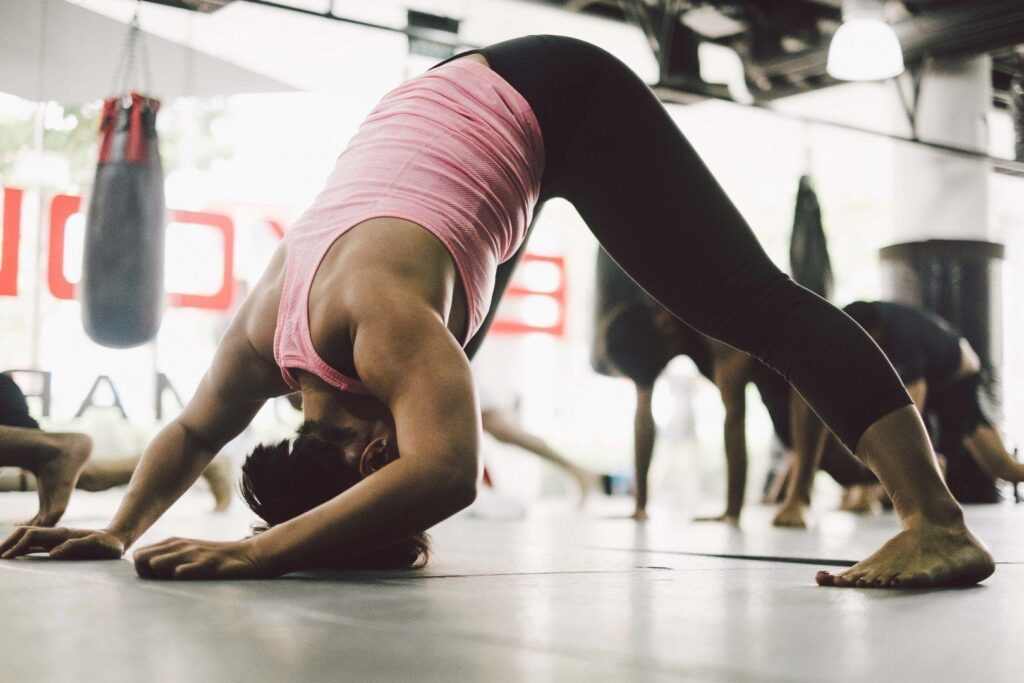After an intense mixed martial arts (MMA) training session, it’s essential to give your body the cool-down it deserves to prevent injuries and aid in recovery. In this article, you will discover a range of effective cooling down exercises specifically designed for MMA fighters. These exercises will help you lower your heart rate, decrease muscle soreness, and improve flexibility, allowing you to stay in peak physical condition and minimize the risk of future injuries. So, grab a towel and get ready to cool down like a pro!

Importance of Cooling Down
When it comes to an intense sport like MMA, cooling down after a training session or a fight is crucial. Cooling down refers to the activities performed after strenuous physical activity to gradually bring the body back to its normal state. It may sound like an optional step, but it offers numerous benefits that should not be overlooked.
Reducing Muscle Soreness
One of the key benefits of cooling down is the reduction of muscle soreness. When you engage in intense physical activity, your muscles experience microscopic tears and inflammation. Cooling down allows the body to gradually relax, lowering the chances of experiencing excessive muscle soreness. By incorporating specific cooling down exercises, you can minimize the discomfort and stiffness that often follow a rigorous MMA training session.
Promoting Muscle Recovery
Another advantage of a proper cool down is that it promotes muscle recovery. After an intense workout, your muscles are in need of nutrients and oxygen to repair and rebuild. Cooling down helps facilitate the delivery of these essential elements by increasing blood circulation. This boost in blood flow aids in the removal of waste products, such as lactic acid, and brings in fresh nutrients, thus supporting muscle recovery and growth.
Preventing Injury
Perhaps the most critical reason to cool down is injury prevention. Cooling down helps gradually lower your heart rate and body temperature, allowing your body to transition from a state of high intensity to a state of rest. This cooldown period helps reduce the risk of sudden drops in blood pressure, dizziness, and potential injuries caused by abrupt stops in physical activity. By taking the time to properly cool down, you can mitigate the chances of muscle strains, sprains, or any other potential injuries.
Cooling Down Exercises
To effectively cool down after an intense MMA session, it’s essential to incorporate specific exercises that target different areas of the body. A well-rounded cooldown routine should include stretching, foam rolling, and light cardiovascular exercises.
Stretching
Stretching is an integral part of any cooldown routine. It helps increase flexibility, release muscle tension, and improve joint range of motion. There are different types of stretching exercises that you can choose from depending on your needs and preferences.
-
Static Stretching: This involves holding a muscle in a lengthened position for a certain period. It helps relax the muscles and improve overall flexibility.
-
Dynamic Stretching: Unlike static stretching, dynamic stretching involves moving a muscle or joint through its full range of motion. It helps warm up the muscles and prepares them for the next activity.
-
Active Isolated Stretching: This type of stretching focuses on holding each stretch for no more than two seconds. It is believed to improve flexibility without activating the body’s protective mechanisms that limit muscle expansion.
Foam Rolling
Foam rolling, also known as self-myofascial release, is a popular technique used to release tension in the muscles and connective tissues. It involves using a foam roller to apply pressure to specific areas of the body, helping to break up adhesions and improve blood flow.
Benefits of Foam Rolling
Foam rolling offers several benefits that make it an excellent addition to your cooling down routine:
-
Increased Flexibility: Foam rolling can help improve flexibility by releasing tight muscles and increasing joint range of motion.
-
Enhanced Recovery: By targeting muscle knots and trigger points, foam rolling can promote muscle recovery and reduce post-workout soreness.
-
Injury Prevention: Regular foam rolling can help prevent injuries by identifying and addressing muscle imbalances or tight areas before they become problematic.
Foam Rolling Techniques
To effectively use a foam roller, follow these techniques:
-
Rolling: Place the foam roller under the targeted muscle group and slowly roll back and forth. Apply moderate pressure, focusing on any tight spots or areas of discomfort.
-
Holding: When you encounter a particularly tight area or trigger point, hold the foam roller on that spot for about 20-30 seconds to allow the muscle to release and relax.
-
Cross Friction: To target small areas or specific muscle fibers, you can apply cross friction by using small back-and-forth movements over the muscle.
Remember to breathe deeply and maintain good posture throughout the foam rolling session to maximize its effectiveness.
Light Cardiovascular Exercise
Light cardiovascular exercise is an essential component of a proper cooldown routine. It helps gradually bring down your heart rate and body temperature, aiding in the transition from high-intensity exercise to a state of rest.
Benefits of Light Cardiovascular Exercise
Participating in light cardiovascular exercise during your cooldown offers various advantages, such as:
-
Improved Circulation: Engaging in light cardiovascular activity helps restore regular blood flow, delivering vital nutrients and oxygen to your muscles.
-
Muscle Relaxation: Light cardio exercises help the muscles gradually relax, reducing the tension built up during intense training sessions.
-
Mental Relaxation: After an intense workout, light cardiovascular exercise can provide a sense of mental relaxation and calmness, allowing you to wind down and reflect on your session.
Examples of Light Cardiovascular Exercises
Some examples of light cardiovascular exercises suitable for your cooldown routine include:
-
Brisk Walking: A gentle stroll or brisk walk for 10-15 minutes can help get your heart rate down while keeping your muscles active.
-
Cycling: Hop on a stationary bike or take a leisurely bike ride to engage your lower body muscles and gradually bring your heart rate down.
-
Swimming: If you have access to a pool, a few laps of gentle swimming can be an excellent way to cool down and engage your entire body.
Incorporating Cooling Down into MMA Training
Now that you understand the importance of cooling down and the various exercises involved, it’s essential to know how to incorporate them effectively into your MMA training routine.
Timing of Cooling Down Exercises
Ideally, you should start your cooldown routine immediately after your intense training session or fight. This ensures that you give your body ample time to gradually transition from a state of high intensity to a state of rest. Aim to spend around 10-15 minutes on your cooldown.
Integrating Specific Movements
When cooling down for MMA, it’s beneficial to incorporate movements that mimic the actions performed during the training session. For example, if you had an intense session focusing on kicks, you could include gentle kicks or knee raises in your cooldown routine. This helps the body transition smoothly and provides a gradual reduction in intensity.
Variations for Different Training Sessions
Different MMA training sessions may require specific cooldown exercises. For instance, after a high-intensity grappling session, it may be beneficial to focus more on stretching and foam rolling to release tension in the muscles and joints. On the other hand, after a striking-focused session, light cardiovascular exercises can help bring down your heart rate and cool the body down.
Common Mistakes to Avoid
While the benefits of cooling down are evident, there are several common mistakes that individuals often make when it comes to this crucial step. By being aware of these mistakes, you can ensure that your cooldown routine is effective and safe.
Skipping the Cooling Down Process
One of the most significant mistakes individuals make is skipping the cooling down process altogether. With the adrenaline and fatigue experienced after an intense MMA session, it can be tempting to head straight to the locker room or engage in other activities. However, neglecting to cool down can increase the risk of muscle soreness, delayed recovery, and potential injuries.
Inadequate Stretching
Another common mistake is performing inadequate stretching during the cooldown. It’s crucial to give sufficient attention to each muscle group and engage in stretching exercises that target specific areas. Skipping or rushing through stretches can limit the benefits and leave your muscles tight and prone to injury.
Overstretching or Overexertion
While stretching is essential, it’s equally important to avoid overstretching or overexertion. Pushing your muscles beyond their limits during the cooldown phase can lead to strains or sprains. Remember to listen to your body and avoid any painful or uncomfortable movements. Stretching should be done gently and only to the point of mild discomfort, not pain.

Recovery Strategies
Apart from cooling down, there are other recovery strategies that can complement the cooldown process and aid in overall recovery and injury prevention.
Proper Nutrition and Hydration
Proper nutrition and hydration play a crucial role in the recovery process after intense physical activity. It’s important to replenish your body with the necessary nutrients and fluids to support muscle repair and growth. Consume a balanced meal or snack containing adequate protein, carbohydrates, and healthy fats within one to two hours post-cooldown. Additionally, stay hydrated by drinking plenty of water throughout the day.
Rest and Sleep
Rest and sleep are vital aspects of recovery that should not be underestimated. Allow your body to rest and recover by prioritizing quality sleep. Aim for seven to nine hours of sleep each night to ensure proper muscle repair and hormonal balance.
Active Recovery Techniques
In addition to complete rest, active recovery techniques can help stimulate blood circulation, reduce muscle stiffness, and expedite the recovery process. Examples of active recovery include light stretching, low-impact exercises, or engaging in activities like yoga or Pilates. These activities promote relaxation, flexibility, and overall well-being.
Professional Recommendations
When it comes to cooling down in MMA, it’s always beneficial to seek advice from experienced trainers and athletes who have firsthand knowledge of the sport. They understand the specific demands and requirements of MMA training and can provide valuable recommendations.
Advice from MMA Trainers and Athletes
MMA trainers and athletes recommend prioritizing the cooldown process to ensure optimal recovery and injury prevention. They emphasize the importance of incorporating a variety of cooling down exercises, such as stretching, foam rolling, and light cardiovascular activities. By following a well-designed cooldown routine, fighters can enhance their overall performance and longevity in the sport.
Best Practices for Cooling Down in MMA
Based on the advice of professionals, here are some best practices for cooling down in MMA:
-
Individualize Your Cooldown: Understand your body and tailor your cooling down routine to suit your specific needs and preferences. Experiment with different exercises and techniques to find what works best for you.
-
Consistency is Key: Make cooling down a regular part of your MMA training routine. Consistently incorporating a cooldown will not only improve your recovery but also establish a healthy habit that supports your overall well-being.
-
Listen to Your Body: Pay attention to any discomfort or pain during the cooling down exercises. If something doesn’t feel right, modify or skip that particular exercise to avoid potential injuries.
Conclusion
Cooling down is a critical aspect of MMA training that should not be overlooked. It offers numerous benefits, including reduced muscle soreness, enhanced muscle recovery, and injury prevention. By incorporating specific cooling down exercises like stretching, foam rolling, and light cardiovascular activities, you can optimize your recovery and maintain a healthy body. Remember to listen to your body, avoid common mistakes, and utilize professional recommendations to ensure effective and safe cooling down practices. Prioritize your recovery, and you’ll be setting yourself up for success in your MMA journey.


